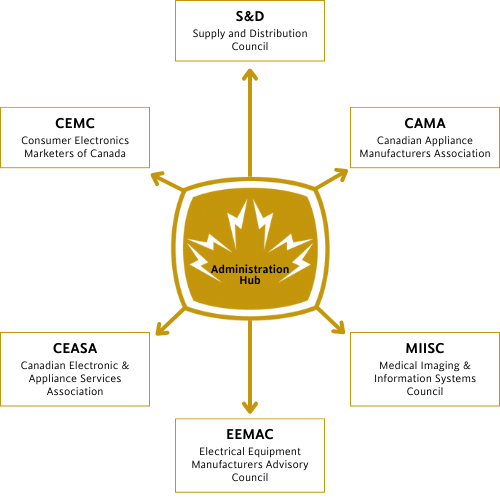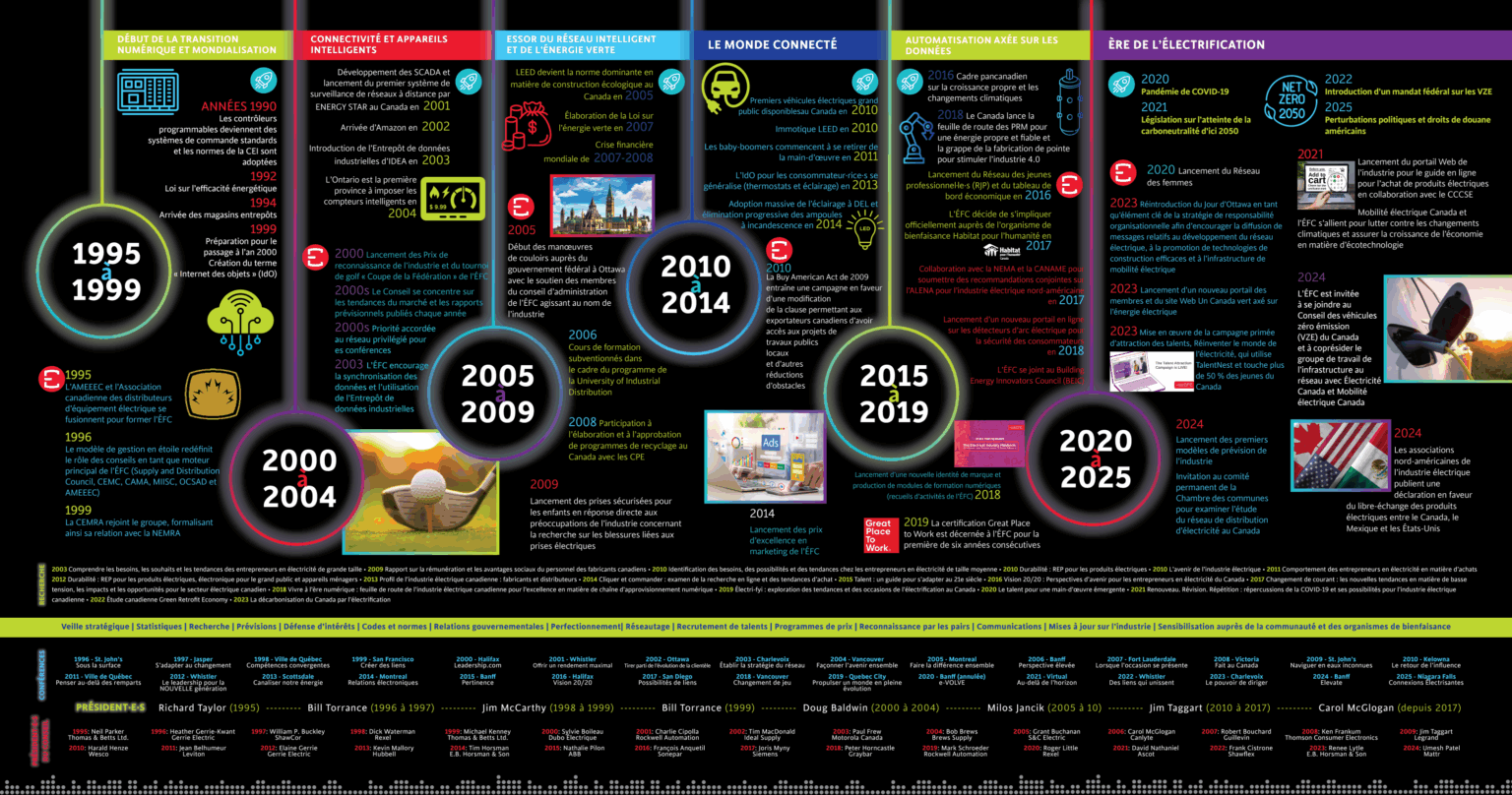
Nous célébrons 30 ans de progrès alimentés par l’innovation, la collaboration et le leadership dans notre industrie. En soulignant cet anniversaire, nous sommes fier·ère·s de réfléchir aux décennies de transformation qui ont façonné EFC et l’industrie électrique partout au Canada.
1995 à 2004
Jeter les bases
L’adaptabilité précoce en réponse au marché a préparé le terrain pour la croissance de l’industrie et de l’association
-
Le milieu des années 1990 a marqué une période de transformation pour l’industrie électrique canadienne. Avec la mise en œuvre de la Loi sur l’efficacité énergétique en 1992, l’arrivée de grandes surfaces comme Home Depot en 1994 et l’adoption par l’ensemble de l’industrie de contrôleurs programmables comme systèmes de commande standard, une industrie en pleine mutation a donné naissance à l’Électro-Fédération Canada (ÉFC).
 En 1995, deux organisations établies, l’Association des manufacturiers d’équipement électrique et électronique du Canada (AMEEEC) et l’Association canadienne des distributeurs d’équipement électrique, ont reconnu la puissance de la collaboration et ont fusionné pour former l’ÉFC. Cette union stratégique a permis de réunir les fabricants et les distributeurs sous un même toit, créant ainsi une voix plus unifiée pour l’industrie électrique.
En 1995, deux organisations établies, l’Association des manufacturiers d’équipement électrique et électronique du Canada (AMEEEC) et l’Association canadienne des distributeurs d’équipement électrique, ont reconnu la puissance de la collaboration et ont fusionné pour former l’ÉFC. Cette union stratégique a permis de réunir les fabricants et les distributeurs sous un même toit, créant ainsi une voix plus unifiée pour l’industrie électrique. La même année, l’ÉFC a lancé un programme de bourses d’études destiné à promouvoir l’éducation postsecondaire et l’emploi dans les domaines de l’électricité, de l’électronique et des télécommunications, une initiative qui continue aujourd’hui de cultiver les talents de l’industrie.
La croissance par l’intégration
 La mise en œuvre du modèle de la gestion en étoile, qui a redéfini le rôle des conseils internes du groupe en tant que moteurs essentiels de l’organisation, a marqué un tournant dans le développement initial de l’ÉFC en 1996. Ce modèle a permis de créer des conseils spécialisés, notamment le Supply and Distribution Council, Mercaticiens de produits électroniques de consommation du Canada (CEMC), l’Association canadienne des fabricants de gros appareils ménagers (CAMA), le Medical Imaging & Information Systems Council (MIISC), l’Organisation canadienne de service d’appareils domestiques (OCSAD) et l’Association des manufacturiers d’équipement électrique et électronique du Canada (AMEEEC).
La mise en œuvre du modèle de la gestion en étoile, qui a redéfini le rôle des conseils internes du groupe en tant que moteurs essentiels de l’organisation, a marqué un tournant dans le développement initial de l’ÉFC en 1996. Ce modèle a permis de créer des conseils spécialisés, notamment le Supply and Distribution Council, Mercaticiens de produits électroniques de consommation du Canada (CEMC), l’Association canadienne des fabricants de gros appareils ménagers (CAMA), le Medical Imaging & Information Systems Council (MIISC), l’Organisation canadienne de service d’appareils domestiques (OCSAD) et l’Association des manufacturiers d’équipement électrique et électronique du Canada (AMEEEC). « Nous rassemblions toutes ces associations indépendantes et nous apprenions beaucoup les uns des autres », se souvient Heather Gerrie de Gerrie Electric, qui a été présidente en 1996. « Il était essentiel pour nous de comprendre et de partager les occasions, les défis et d’identifier les synergies entre nous pour trouver ensemble des solutions. Nous avions une histoire fantastique à raconter, et c’était une période très excitante. »
 L’ÉFC a continué d’étendre son influence grâce à l’intégration stratégique d’organisations clés. En 1999, la Canadian Electrical Manufacturers Representatives Association (CEMRA) a adhéré au groupe et a établi des liens formels avec la National Electrical Manufacturers Representatives Association (NEMRA), permettant ainsi une affiliation conjointe pour ceux·celles qui deviennent membres de l’ÉFC. Cette initiative a permis de renforcer les liens entre les représentant·e·s de fabricants canadien·ne·s et américain·e·s.
L’ÉFC a continué d’étendre son influence grâce à l’intégration stratégique d’organisations clés. En 1999, la Canadian Electrical Manufacturers Representatives Association (CEMRA) a adhéré au groupe et a établi des liens formels avec la National Electrical Manufacturers Representatives Association (NEMRA), permettant ainsi une affiliation conjointe pour ceux·celles qui deviennent membres de l’ÉFC. Cette initiative a permis de renforcer les liens entre les représentant·e·s de fabricants canadien·ne·s et américain·e·s. Le tournant du millénaire a donné lieu à de nouvelles initiatives visant à renforcer les liens avec l’industrie. En 2000, l’ÉFC a lancé les Prix de reconnaissance de l’industrie pour récompenser les contributions individuelles exceptionnelles aux industries canadiennes de l’électricité, de l’électroménager, de l’électronique ou des télécommunications. La même année a vu la mise en place de deux événements de réseautage qui deviendront des traditions de l’industrie : le tournoi de golf du Québec en mai et le tournoi de golf de la Coupe de la Fédération en août. Ces événements, ainsi que les conférences annuelles organisées dans toute l’Amérique du Nord, ont fourni aux professionnel·le·s de l’industrie des plateformes précieuses pour réseauter, partager des idées et nouer des relations, ce que l’ancien président de Rockwell Automation, Charlie Cipolla, souligne comme étant inestimable.
« Le forum de l’ÉFC est un lieu idéal pour que les gens se rencontrent lors d’événements. C’est l’endroit où vous pouvez rencontrer vos concurrent·e·s, vos distributeurs et aborder des sujets communs pour ainsi régler vos problèmes. Je ne sais pas comment il est possible de mettre un prix là-dessus », affirme-t-il.
En 2004, l’Organisation canadienne de service d’appareils domestiques (OCSAD) avait rejoint l’ÉFC en tant que conseil à part entière, élargissant encore le champ d’action de la fédération et la représentation de l’industrie.
Composer avec les transformations de l’industrie
 Tout au long de ces années fondamentales, l’ÉFC a fait preuve d’une remarquable capacité d’adaptation pour réagir aux changements rapides de l’industrie. En 1999 (l’année de création du terme « Internet des objets » [IdO]), l’organisation a aidé ses membres à se préparer au passage à l’an 2000. L’arrivée d’Amazon en 2002 a marqué l’avènement d’un commerce électronique perturbé, tandis que le mandat de 2004 de l’Ontario pour les compteurs intelligents a ouvert une nouvelle ère dans le domaine du contrôle de la consommation de l’énergie.
Tout au long de ces années fondamentales, l’ÉFC a fait preuve d’une remarquable capacité d’adaptation pour réagir aux changements rapides de l’industrie. En 1999 (l’année de création du terme « Internet des objets » [IdO]), l’organisation a aidé ses membres à se préparer au passage à l’an 2000. L’arrivée d’Amazon en 2002 a marqué l’avènement d’un commerce électronique perturbé, tandis que le mandat de 2004 de l’Ontario pour les compteurs intelligents a ouvert une nouvelle ère dans le domaine du contrôle de la consommation de l’énergie.« L’ÉFC a accompli beaucoup de bon travail pour soutenir les codes et les normes au Canada. Elle a fait un excellent travail sur les mesures anti-contrefaçon et pour veiller à ce que la sécurité des produits au moyen de la lutte anti-contrefaçon et des codes et normes soit prioritaire », note M. Grant Buchanan de S&C Electric, qui a été président du conseil en 2005, évoquant l’incidence initiale de l’organisation tout au long de sa première décennie d’existence.
En l’espace d’une décennie, l’ÉFC s’est imposée comme une organisation essentielle de l’industrie en rassemblant diverses parties prenantes, en fournissant des services précieux et en aidant le secteur de l’électricité à traverser les transitions technologiques et commerciales.
Reposant sur l’unité, l’adaptabilité et la réflexion prospective, les fondations bâties par l’ÉFC au cours de ces années formatrices l’ont aidée à développer une plateforme solide pour continuer à mener l’industrie électrique canadienne à travers les changements encore plus spectaculaires des décennies à venir.
2005 à 2014
Composer avec la transformation
Les façons dont le leadership de l’ÉFC met l’industrie électrique sur la voie de la réussite
-
 La décennie allant de 2005 à 2014 a redéfini le fonctionnement de l’industrie électrique d’aujourd’hui. Grâce à la promotion des énergies renouvelables et propres, aux virages à grande échelle en faveur de l’automatisation et de la robotique, et aux progrès des véhicules électriques, le monde est devenu plus connecté et efficace que jamais, et l’industrie a célébré des jalons, notamment la commercialisation des premiers véhicules électriques du marché de masse au Canada (2010), la généralisation de l’IdO grand public (2013) et l’adoption massive de la technologie à DEL (2014).
La décennie allant de 2005 à 2014 a redéfini le fonctionnement de l’industrie électrique d’aujourd’hui. Grâce à la promotion des énergies renouvelables et propres, aux virages à grande échelle en faveur de l’automatisation et de la robotique, et aux progrès des véhicules électriques, le monde est devenu plus connecté et efficace que jamais, et l’industrie a célébré des jalons, notamment la commercialisation des premiers véhicules électriques du marché de masse au Canada (2010), la généralisation de l’IdO grand public (2013) et l’adoption massive de la technologie à DEL (2014).Au fil de ces années, l’ÉFC a continué à jouer son rôle de boussole de l’industrie. Aidant ses membres à faire face aux bouleversements technologiques, aux défis économiques et aux complexités réglementaires, elle a tenu la barre d’une main ferme pour guider l’industrie à travers ces changements importants.
Priorité à l’éducation et au transfert de connaissances
 Bien que la crise financière mondiale de 2007-2008 ait provoqué des turbulences économiques, l’ÉFC a aidé ses membres à trouver leur équilibre, en mettant à profit cette période pour repenser les approches et renforcer les principaux modèles d’entreprise. Les initiatives prises au cours de cette période visaient à renforcer la résilience de l’industrie et à encourager l’innovation malgré des conditions de marché difficiles, en créant un héritage d’engagement en faveur de la formation et du perfectionnement professionnel. Ces efforts comprenaient une série de cours de formation commandités par le Supply and Distribution Council dans le cadre du programme de la University of Industrial Distribution de 2006, et des partenariats éducatifs, tels que le « Industrial Distribution Leadership Certification Program (IDLCP) » (Programme de certification du leadership en distribution industrielle [PCLDI]) au Mohawk College en Ontario et au British Columbia Institute of Technology, en collaboration avec la Power Transmission Distributors Association (PTDA), dans le cadre de l’initiative plus vaste Industrial Careers Pathway en 2008. L’ÉFC a élargi sa portée en matière de formation en 2012 avec le programme de niveau Bronze du cours de formation sur les produits électriques (EPEC) en français, en partenariat avec la National Association of Electrical Distributors (NAED), garantissant ainsi l’accessibilité des ressources de formation aux professionnel·le·s du pays.
Bien que la crise financière mondiale de 2007-2008 ait provoqué des turbulences économiques, l’ÉFC a aidé ses membres à trouver leur équilibre, en mettant à profit cette période pour repenser les approches et renforcer les principaux modèles d’entreprise. Les initiatives prises au cours de cette période visaient à renforcer la résilience de l’industrie et à encourager l’innovation malgré des conditions de marché difficiles, en créant un héritage d’engagement en faveur de la formation et du perfectionnement professionnel. Ces efforts comprenaient une série de cours de formation commandités par le Supply and Distribution Council dans le cadre du programme de la University of Industrial Distribution de 2006, et des partenariats éducatifs, tels que le « Industrial Distribution Leadership Certification Program (IDLCP) » (Programme de certification du leadership en distribution industrielle [PCLDI]) au Mohawk College en Ontario et au British Columbia Institute of Technology, en collaboration avec la Power Transmission Distributors Association (PTDA), dans le cadre de l’initiative plus vaste Industrial Careers Pathway en 2008. L’ÉFC a élargi sa portée en matière de formation en 2012 avec le programme de niveau Bronze du cours de formation sur les produits électriques (EPEC) en français, en partenariat avec la National Association of Electrical Distributors (NAED), garantissant ainsi l’accessibilité des ressources de formation aux professionnel·le·s du pays.Consciente de la valeur des informations sur le marché et des connaissances privilégiées au sein de l’organisation, l’ÉFC a donné la priorité à la recherche sur l’industrie tout au long de cette décennie, publiant plusieurs rapports à la fois individuellement et dans le cadre de partenariats. Publié par l’ÉFC en 2014 (en anglais seulement), le rapport Click and Order: Examining Online Research & Purchasing Trends of Canadian Electrical Customers, a jeté les bases pour plusieurs autres rapports de recherche sur l’industrie parus dans les années suivantes, notamment Les chaînes d’approvisionnement numériques dans l’industrie électrique (2018), Le talent pour une main-d’œuvre émergente (2020) et La décarbonisation du Canada par l’électrification (2023).
Pleins feux sur la sécurité
L’innovation en matière de sécurité est devenue un autre aspect marquant de cette décennie, avec le lancement de l’initiative des prises sécurisées pour les enfants en 2009, en réponse directe aux préoccupations de l’industrie concernant la recherche sur les blessures liées aux prises électriques. Cet engagement en faveur de la protection des consommateur·rice·s a démontré le leadership de l’ÉFC quant à la réponse proactive aux préoccupations émergentes de sécurité, rappelle Jim Taggart, de Legrand Canada, qui a été président du conseil d’administration en 2009 et président de 2010 à 2017.
« L’ÉFC a fait un travail remarquable en encourageant l’adoption de dispositifs de sécurité électriques, tels que les disjoncteurs de fuite à la terre et les disjoncteurs combinés anti-arc, déclare-t-il. Ces dispositifs ont permis de sauver des vies et d’éviter des brûlures et des blessures. »
L’année suivante, l’ÉFC a lancé une campagne anti-contrefaçon intitulée « Don’t Be Shocked. Buy Authentic. » (Évitez les chocs. Optez pour l’authenticité.), en conjonction avec le Mois de la sensibilisation à la sécurité en électricité. Grant Buchanan, président du conseil de S&C Electric en 2005, se souvient de cette campagne comme d’une réalisation majeure. « L’ÉFC a accompli beaucoup d’excellent travail pour soutenir les codes et les normes au Canada, notamment concernant les mesures anti-contrefaçon et pour veiller à ce que la sécurité des produits au moyen de la lutte anti-contrefaçon et des codes et normes soit prioritaire », note M. Buchanan.
Établissement d’une voix puissante en faveur de l’industrie et de la défense des intérêts

Consciente de l’importance de l’influence politique, l’ÉFC a amorcé des manœuvres de couloirs auprès du gouvernement fédéral à Ottawa en 2005, avec le soutien des membres du conseil d’administration agissant au nom de l’industrie. M. Buchanan affirme que les efforts déployés étaient grands, en particulier pour une association à un stade aussi précoce. « Beaucoup d’entreprises dont la direction est basée aux États-Unis faisaient déjà des manœuvres de couloirs. Nous avons donc dû coordonner nos efforts pour ne pas nous marcher sur les pieds », se souvient-il.
Selon Tim MacDonald (Ideal Supply), qui a présidé le conseil en 2002, malgré les difficultés, le pouvoir de plaidoyer collectif s’est avéré inestimable dans les décennies suivantes : « À mon avis, la présence de l’ÉFC à Ottawa, l’organisation de Jours d’Ottawa et la rencontre avec des ministres du cabinet, des député·e·s et des fonctionnaires ayant une certaine influence sur l’industrie figurent parmi les réalisations les plus positives que nous ayons faites au fil des ans. »
Ces capacités se sont avérées particulièrement précieuses en 2010, lorsque l’ÉFC a réussi à faire adopter un amendement à la Buy American Act de 2009, qui a assoupli la clause permettant aux exportateurs du Canada d’avoir accès aux projets de travaux publics dans le cadre de l’American Recovery and Reinvestment Act, ainsi que d’autres réductions d’obstacles et des dispositions accélérées pour le règlement de différends.
« Cet accord confirme l’importance des entreprises canadiennes pour l’économie américaine et permet à notre industrie d’accéder une fois de plus à des possibilités qui ne feront que renforcer les économies américaine et canadienne », a déclaré Milos Jancik, président de l’ÉFC de 2005 à 2010, à propos de l’initiative de modification de la Buy American Act.
Une base pour la réussite future
Des manœuvres de couloirs aux campagnes de sécurité, en passant par les programmes éducatifs et la recherche sur l’industrie, le leadership de l’ÉFC pendant des années d’incertitude et de changement a permis à ses membres de se positionner pour réussir à long terme. De 2005 à 2014, il ne s’agissait pas seulement de survivre au changement, mais de l’accueillir et de le canaliser pour accroître la prospérité de l’industrie.
« L’ÉFC a vraiment été le ciment de l’industrie, dans les bons moments comme dans les mauvais, déclare Kevin Mallory, de Hubbell Canada, qui a été président du conseil en 2013. C’est certainement l’un des canaux de communication les plus efficaces quant à ce qui se passe dans l’industrie et aux acteur·rice·s. L’organisation s’est vraiment renforcée, en particulier ces dernières années, comme point de ralliement en matière de communication et de causes. »
2015 à 2025
S’ouvrir à l’avenir électrifié
Le rôle de l’ÉFC pour aider l’industrie à rester concurrentielle et à prospérer dans un monde dominé par l’électricité.
-
Si les 20 premières années d’existence de l’Électro-Fédération Canada (ÉFC) ont été marquées par la croissance et le leadership, la dernière décennie a été caractérisée par une transformation de l’association en une ressource concurrentielle pour ses membres. Alors que l’industrie électrique fait face à des défis et à des incertitudes causés par la perturbation numérique, les problèmes liés à la chaîne d’approvisionnement, la pénurie de main-d’œuvre qualifiée et les changements réglementaires, les offres innovantes de l’ÉFC continuent d’aider les membres à prospérer.
L’information commerciale, un avantage concurrentiel
La nécessité de prendre des décisions éclairées n’a jamais été aussi cruciale qu’aujourd’hui, et cela a été particulièrement vrai au cours de la dernière décennie. L’industrie 4.0 a engendré une demande accrue d’appareils intelligents et de plateformes infonuagiques, de concert avec une préoccupation croissante pour la résilience climatique et la décentralisation du réseau. L’intelligence artificielle a changé la donne en matière d’automatisation, alors que les énergies renouvelables et les efforts de décarbonisation à l’échelle mondiale étaient en cours. Au moment où les secteurs d’activité montraient des signes d’optimisme prudent, une pandémie mondiale et des conflits commerciaux ont entraîné une incertitude durable.
Pour répondre à la demande croissante d’informations de ses membres, l’ÉFC a mis à profit ses compétences en analyse de données en créant l’indicateur de l’ÉFC, un rapport économique publié trois fois par an avant le lancement du tableau de bord économique en 2016. Ce rapport est rapidement devenu une source unique d’indicateurs clés du marché, permettant aux entreprises de comparer leurs rendements et de repérer les possibilités émergentes.
« Le nouveau tableau de bord arrive au bon moment pour que l’ÉFC puisse offrir à ses membres des services statistiques novateurs et plus complets », a affirmé David Nathaniel, Standard Products, président du comité statistique de l’ÉFC, à propos du lancement de l’édition 2016. « En collaboration avec le comité statistique nouvellement formé, nous avons lancé cette nouvelle plateforme afin de fournir aux membres des mises à jour continues sur les performances économiques. »
Cette détermination en faveur d’une prise de décision fondée sur les données s’est poursuivie jusqu’en 2024 avec l’introduction de modèles de prévision industrielle qui ont révolutionné la planification stratégique, comme le souligne Mark Schroeder de Rockwell Automation, président du conseil en 2019. « L’ÉFC a évolué en fonction des besoins de ses membres. Mais, en tant que fabricant, il n’y a qu’un élément auquel je pense, soit les données fiables. Elles nous fournissent une perspective et nous permettent de prendre des décisions, déclare-t-il. En tant que fabricant, nous pouvions fournir des données sensibles à l’ÉFC, qui les traitait comme telles, et recevoir en échange des données générales sur l’industrie. Cela nous permettait d’avoir une perspective et de prendre des décisions. C’est essentiel. »
Lorsque les méthodes de prévision traditionnelles ont échoué pendant la pandémie de COVID-19, l’ÉFC a rapidement déployé de la méthode des Sondages d’opinion pour fournir aux membres des informations essentielles en temps réel. Cela leur a permis de faire face à la volatilité sans précédent des marchés. Cette méthode agile de collecte d’information commerciale est devenue permanente, les sondages trimestriels continuant à fournir des informations sur la concurrence. Elaine Gerrie, de Gerrie Electric, qui a été présidente du conseil d’administration en 2012, considère cela comme une réalisation majeure pour l’entreprise : « L’ÉFC occupe une place centrale en fournissant des données et une expertise à nos membres, et en nous aidant à rester uni·e·s et à maintenir des liens étroits avec nos partenaires de la chaîne d’approvisionnement. Elle nous offre une plateforme favorisant un mouvement unifié parmi les distributeurs, nous permettant de progresser dans notre industrie. De plus, elle fournit les statistiques nécessaires pour gérer nos entreprises et nous soutient avec des informations et une voix politique en période de crise. »
La collaboration au service de la compétitivité
L’une des plus grandes forces de l’ÉFC réside dans sa capacité à rassembler les parties prenantes de l’industrie grâce à son réseau en pleine expansion. L’organisation a lancé son Réseau des jeunes professionnel·le·s (RJP) en 2016, puis le Réseau des femmes en 2020, créant ainsi des plateformes qui permettent à ces groupes démographiques clés de tisser des liens et de développer leur carrière. Au cours des dernières années, des réseaux spécialisés, notamment dans les domaines des TI et de la chaîne d’approvisionnement, ont été instaurés afin de faire face aux priorités et aux défis émergents de l’industrie, offrant ainsi à toutes les parties prenantes, quels que soient leur rôle et leur niveau d’expérience, des occasions de réseauter et de se développer.
Cet avantage collaboratif s’est révélé particulièrement précieux lors des récentes perturbations du marché. Lorsque les droits de douane imposés par les États-Unis ont menacé de bouleverser les modèles commerciaux en 2025, la création rapide d’un sondage sur les droits de douane et d’un centre de ressources centralisé par l’ÉFC a permis aux membres d’évaluer rapidement les répercussions et d’élaborer des stratégies d’atténuation. De plus, alors que diverses industries sont confrontées à une pénurie de main-d’œuvre, la campagne primée de l’ÉFC, « Réinventer le monde de l’électricité », a fait la promotion de différentes carrières dans l’industrie électrique et a souligné les occasions affichées sur le tableau d’affichage des offres d’emploi TalentNest, une initiative qui accompagne la rédaction des recueils d’activités de l’ÉFC afin de fournir aux nouveaux·elles membres de l’industrie de précieuses ressources de formation.
Au fil des ans, les efforts de promotion de l’ÉFC ont constamment contribué à l’industrie, plaçant ses membres à l’avant-garde du mouvement d’électrification au Canada grâce à un engagement stratégique auprès du gouvernement. En 2022, l’ÉFC a instauré le réseau Un Canada vert axé sur l’énergie électrique, puis a lancé en 2023 un portail Web consacré aux occasions de transition vers la carboneutralité, afin d’informer ses membres au sujet des changements et des tendances émergentes. Plus particulièrement, l’invitation reçue par l’ÉFC en 2024 pour se joindre au Conseil des véhicules zéro émission (VZE) du Canada, où elle copréside le groupe de travail de l’infrastructure au réseau, a permis à ses membres de siéger à la table où les décisions relatives à l’infrastructure de la mobilité électrique sont prises.
« L’ÉFC est un catalyseur de progrès. Je pense que les prochaines années, et même les 30 prochaines années, vont être marquées par un changement fondamental pour nous tous », note Renee Lytle, E.B. Horsman & Son, qui a été présidente du conseil d’administration en 2023. « Les entreprises et les dirigeant·e·s qui prospèrent et embrassent ce changement et qui investissent dans la technologie, notre personnel et nos méthodes de collaboration feront la différence. Et je pense que l’ÉFC est particulièrement bien placée pour nous aider à collaborer et à nous préparer pour l’avenir. »

 Pour répondre à la demande croissante d’informations de ses membres, l’ÉFC a mis à profit ses compétences en analyse de données en créant l’indicateur de l’ÉFC, un rapport économique publié trois fois par an avant le lancement du tableau de bord économique en 2016. Ce rapport est rapidement devenu une source unique d’indicateurs clés du marché, permettant aux entreprises de comparer leurs rendements et de repérer les possibilités émergentes.
Pour répondre à la demande croissante d’informations de ses membres, l’ÉFC a mis à profit ses compétences en analyse de données en créant l’indicateur de l’ÉFC, un rapport économique publié trois fois par an avant le lancement du tableau de bord économique en 2016. Ce rapport est rapidement devenu une source unique d’indicateurs clés du marché, permettant aux entreprises de comparer leurs rendements et de repérer les possibilités émergentes.
